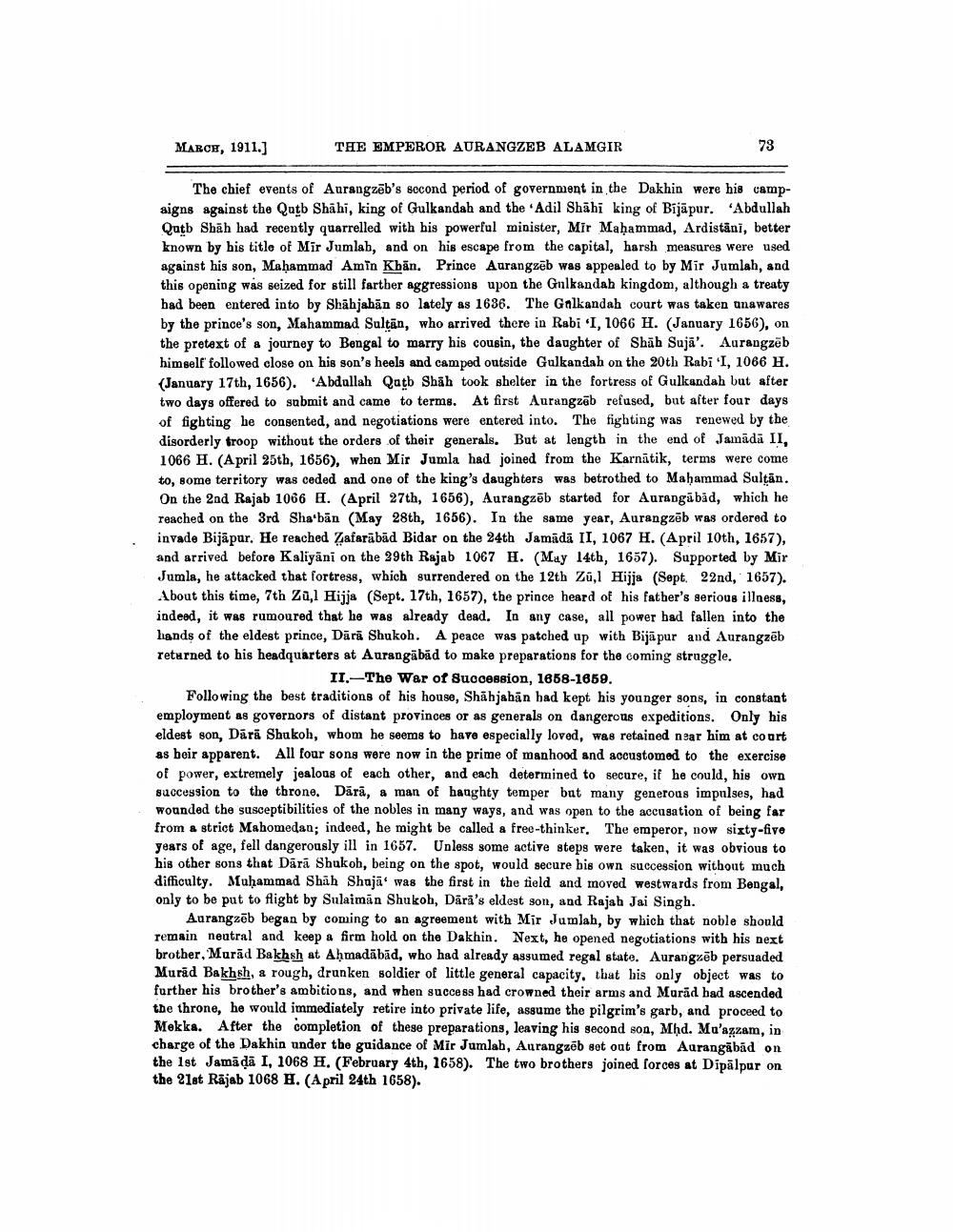________________
MARCH, 1911.)
THE EMPEROR AURANGZEB ALAMGIR
73
The chief events of Aurangzēb's socond period of government in the Dakhin were his campaigns against the Qutb Shahi, king of Gulkandah and the Adil Shāhi king of Bijapur. 'Abdullah Qutb Shāh had recently quarrelled with his powerful minister, Mir Mahammad, Ardistäni, better known by his title of Mir Jumlab, and on his escape from the capital, harsh measures were used against his son, Mahammad Amin Khān. Prince Aurangzēb was appealed to by Mir Jumlah, and this opening was seized for still farther aggressions upon the Gulkandah kingdom, although a treaty had been entered into by Shāhjahān so lately as 1636. The Golkandah court was taken anawares by the prince's son, Mahammad Sultan, who arrived there in Rabi 'I, 1066 H. (January 1656), on the pretext of a journey to Bengal to marry his cousin, the daughter of Shāh Sujā'. Aurangzēb himself followed close on his son's heels and camped outside Gulkandah on the 20th Rabi I, 1066 H. (January 17th, 1656). 'Abdullah Qutb Shāh took shelter in the fortress of Gulkandah but after two days offered to submit and came to terms. At first Aurangzāb refused, but after four days of fighting he consented, and negotiations were entered into. The fighting was renewed by the disorderly troop without the orders of their generals. But at length in the end of Jamādā II, 1066 H. (April 25th, 1656), when Mir Jumla had joined from the Karnātik, terms were come to, some territory was ceded and one of the king's daughters was betrothed to Mahammad Sultan. On the 2nd Rajab 1066 . (April 27th, 1656), Aurangzēb started for Aurangābåd, which he reached on the 3rd Sha'bān (May 28th, 1656). In the same year, Aurangzēb was ordered to invade Bijāpar. He reached Zafarābād Bidar on the 24th Jamādā II, 1067 H. (April 10th, 1657), and arrived before Kaliyāni on the 29th Rajab 1067 H. (May 14th, 1657). Supported by Mir Jumla, he attacked that fortress, which surrendered on the 12th Zül Hijja (Sept. 22nd, 1657). About this time, 7th Zal Hijja (Sept. 17th, 1657), the prince heard of his father's serious illness, indeed, it was rumoured that he was already dead. In any case, all power had fallen into the lands of the eldest prince, Dārā Shukoh. A peace was patched up with Bijapur and Aurangzēb returned to his headquarters at Aurangābād to make preparations for the coming struggle.
II.-The War of Succession, 1858-1859. Following the best traditions of his house, Shahjahan bad kept his younger sons, in constant employment as governors of distant provinces or as generals on dangerous expeditions. Only his eldest son, Dārā Shukoh, whom he seems to have especially loved, was retained near him at court as beir apparent. All four sons were now in the prime of manhood and accustomed to the exercise of power, extremely jealous of each other, and each determined to secure, if he could, his own succession to the throne. Dārā, a man of haughty temper bat many generous impulses, had wounded the susceptibilities of the nobles in many ways, and was open to the accusation of being far from a strict Mahomedan; indeed, he might be called a free-thinker, The emperor, now sixty-five years of age, fell dangerously ill in 1657. Unless some active steps were taken, it was obvious to his other sons that Dārā Shukoh, being on the spot, would secure bis own succession without much difficulty. Muhammad Shah Shujā' was the first in the tield and moved westwards from Bengal, only to be put to flight by Sulaiman Shukoh, Dārā's eldest son, and Rajah Jai Singh.
Aurangzēb began by coming to an agreement with Mir Jumlah, by which that noble should remain neutral and keep a firm hold on the Dakhin. Next, he opened negotiations with his next brother, Murād Bakhsh at Ahmadābād, who had already assumed regal state. Aurangzēb persuaded Murad Bakhsh, a rough, drunken soldier of little general capacity. that his only object was to further his brother's ambitions, and when success had crowned their arms and Murād bad ascended the throne, he would immediately retire into private life, assume the pilgrim's garb, and proceed to Mekka. After the completion of these preparations, leaving his second son, Mhd. Mu'azzam, in charge of the Dakhin under the guidance of Mir Jumlah, Aurangzēb set out from Aurangābād on the 1st Jamā dā I, 1068 H. (February 4th, 1658). The two brothers joined forces at Dipālpur on the 21st Rājab 1068 H. (April 24th 1658).




